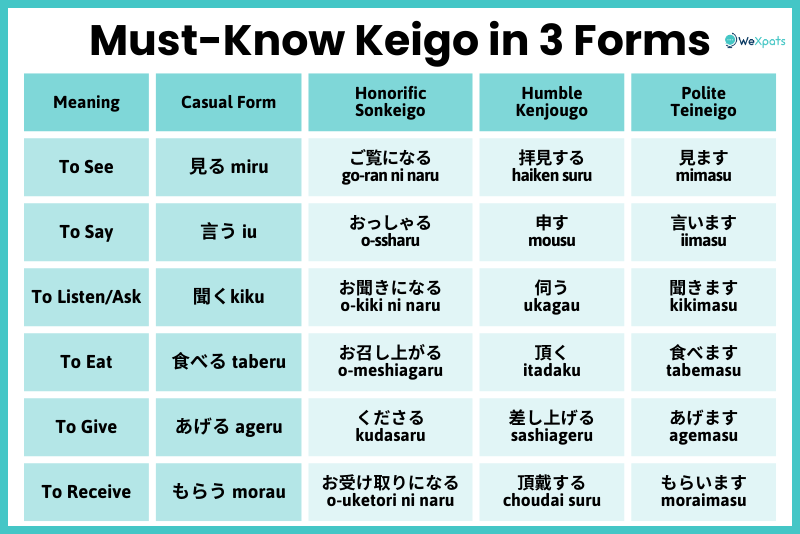Japanese honorific language (敬語, Keigo) is an important part of the Japanese language. It is, however, also one of the most difficult parts of Japanese learning, right next to learning and memorising Kanji.
In this article, we introduce the different types of Japanese honorific language and how to use them properly. We also introduce commonly used Keigo phrases to learn with example sentences, and Keigo that even Japanese people have difficulty with.
First Published: 2022-06-30
Updated: 2024-05-28
Table of Contents
- What is Japanese Honorific Language, Keigo?
- The 5 Types of Japanese Honorific Language and Their Usages
- Important Japanese Honorific Language to Learn
- Common Keigo Mistakes to Look Out For
What is Japanese Honorific Language, Keigo?

Japanese honorific language or Japanese honorific speech, called 敬語 (Keigo) in Japanese, is used to show respect to whomever you are speaking to. The Kanji for 敬語 is 敬 (Kei) meaning “respect” or “reverence”, and 語 (Go) meaning “language” or “speech”. Therefore, Keigo literally means “language (or speech) to show respect".
There are many patterns of speech when it comes to Keigo as well as specific phrases or words to use in specific situations, which we will introduce below.
Japanese honorific language is mainly used when talking to superiors, a respected person, and when meeting someone for the first time. It is imperative to speak using Keigo at work or when doing business. Even if you do not respect the other person, it is basic manners and courtesy to acknowledge their position by speaking to them using Japanese honorific speech.
There are not many languages that use honorific language which is why Keigo comes off as difficult and unfamiliar to many Japanese learners. Let’s take it slow and start with understanding the types of Japanese honorific language there are, followed by learning some commonly used phrases.
Writer's Pick
The 5 Types of Japanese Honorific Language and Their Usages

There are altogether five types of Keigo. Three of them, namely Sonkeigo (尊敬語), Kenjougo (謙譲語) and Teineigo (丁寧語) have been used since olden times. The other two, Teichougo (丁重語) and Bikago (美化語), are new additions to Japanese honorific language having been added in 2007 through the Ministry of Education, Culture, Sports, Science and Technology’s Guideline on Keigo Report.
Sonkeigo (尊敬語) - Honorific Language
Sonkeigo is Keigo used to show respect to whomever you are speaking to or a third party mentioned during conversation. It is used when your conversation partner or the third party mentioned in conversation is someone of higher status. Sonkeigo also functions to elevate the position of said persons.
When must you use Sonkeigo?
Sonkeigo is very important In business settings, when speaking to superiors, clients and customers, etc. important people, which is why you should learn Sonkeigo if you are interested in working in Japan. And, outside of work, when meeting someone for the first time and to your elders.
How to use Sonkeigo?
By adding honorific prefixes お (O-) or ご (Go-) to the front of singular words, which to apply depends on the words origin, but there are exceptions, so the best way is to memorise them. In addition, there are special Keigo phrases and words limited to specific situations.
Kenjougo (謙譲語) - Humble Language
Kenjougo, also called Kensongo (謙遜語), is Keigo used to humble the speaker’s actions as a sign of respect. It also functions to lower the speaker’s position in order to enhance someone else’s status.
How to differentiate between Sonkeigo and Kenjougo?
A common problem for Japanese learners is how to differentiate between Sonkeigo (honorific language) and Kenjougo. The easiest way is to identify the person who is performing the action - the superior or yourself.
For example, the action of reading (読む, Yomu):
-
If the superior is reading, then Sonkeigo (honorific language) applies, thus:
読む becomes 読まれる (Yomameru) or お読みになる (O-Yomi ni naru) -
If you are reading, then Kenjougo (humble language) applies, thus:
読む becomes 拝読する (Haidokusuru)
How to use Kenjougo?
As the example for Kenjougo above shows, there are special Keigo phrases and words limited to specific situations when it comes to Kenjougo too, though different phrases and words from Sonkeigo. The usage of prefixes お (O-) or ご (Go-) to the front of singular words also applies.
For example, the action of seeing or looking (見る, Miru):
- For Sonkeigo, the special Keigo phrase / words is ご覧になる (Goran ni naru)
- For Kenjougo, the special Keigo phrase / words is 拝見する (Haikensuru).
Teineigo (丁寧語) - Polite Language
Teineigo is used regardless of hierarchy, superiority or relationship status to be polite. It has a gentler and softer image compared to the most formal Sonkeigo (honorific language) and formal Kenjougo (humble language). Teineigo has two of the most basic Japanese sentence structures that are taught in beginner Japanese lessons and textbooks.
How to use Teineigo?
Teineigo is done by ending sentences or conjugating words with です (Desu) or ます (Masu). Teineigo is also used in conjunction with Sonkeigo and Kenjougo.
Verb + ます (Masu)
- To eat : 食べる (Taberu) = 食べ
る→ 食べます (Tabemasu) - To buy : 買う (Kau) = 買
う→ 買います (Kaimasu)
Adjectives / Nouns + です (Desu)
- Wonderful : 素敵 (Suteki) → 素敵です (Suteki desu)
- Ramen : ラーメン (Ra-men) → ラーメンです (Ra-men desu)
Learn how to conjugate in the respective JLPT N5 articles - Japanese Verbs here and Adjectives here.
Teichougo (丁重語) - Courteous Language
Teichougo is Keigo used to humble yourself to be polite. Sounds familiar? Teichougo was originally part of Kenjougo (humble language) before the 2007 Keigo Report by MEXT that designated it as a new category of Japanese honorific language.
Teichougo is also called “Kenjougo II”. It is difficult to distinguish between Teichougo and Kenjougo, so most times they are just grouped together as Kenjougo, as it used to be.
How to differentiate between Teichougo and Kenjougo?
When speaking to someone of a higher position then Kenjougo applies. If no higher position person is around, but you still want to humble your position, then Teichougo applies.
For example, the action of going (行く, Iku) or coming (来る, Kuru):
-
For Kenjougo, 行く becomes 参ります (Mairimasu) or 伺います (Ukagaimasu).
Example: 私が参ります/伺います。(watashi ga mairimasu / ukagaimasu) - "I am going / coming." -
For Teichougo, 行くbecomes 参ります (Mairimasu) only. 伺います is not Teichougo.
Example: バスが参ります。(basu ga mairimasu) - "The bus is coming."
Bikago (美化語) - Elegant Speech
Bikago is Keigo used to beautify or make elegant a word or your speech; 美化 (Bika) meaning “beautify”.
How to use Bikago?
By adding prefixes お (O-) or ご (Go-) to the front of singular words. This pattern is also used in Sonkeigo (honorific language) and Kenjougo (humble language).
How to differentiate Bikago, Sonkeigo and Kenjougo?
For Sonkeigo and Kenjougo, the prefixes お (O-) or ご (Go-) are honorific prefixes, added to show respect to someone. Whereas, Bikago is used only to beautify words, and carry no message of honour or respect to anyone.
For example:
- 寿司 (Sushi) → お寿司 (O-Sushi)
- Neighbourhood : 近所 (Kinjo) → ご近所 (Go-Kinjo)
- Seat : 席 (Seki) → お席 (O-Seki)
Whether to use お (O-) or ご (Go-) depends on the word’s origins. The general rule is that お (O) should be used for original Japanese words, and ご (Go-) for Chinese origin words. However, there are exceptions to this rule. We recommend remembering which to use as a set by listening to people speak, or watching Japanese media - anime, J-drama, J-movies.
※ MEXT, “18.文化審議会「敬語の指針」(答申)について”
Important Japanese Honorific Language to Learn

In this part, we will introduce the Japanese Honorific Language that is often used in daily life in Japan. Once you’ve mastered these, you are all set to study, work, and interact with people in Japanese.
Basic Japanese Honorific Language starts to be taught at the JLPT N3 level, while the rest are covered in the JLPT N2 level, which is considered business level Japanese. Therefore, learning these is also helpful for your JLPT N3 and N2 studies in preparation for the test.
|
Meaning |
Casual |
Sonkeigo List |
Kenjougo List |
Teineigo List |
|---|---|---|---|---|
|
To do |
する |
なさる / される 「ご注文は何に |
いたす 「私もご一緒いたし |
します 「毎日1時間日本語の |
|
To see; |
見る |
ご覧になる 「私の母国の写真を |
拝見する 「今から資料を |
見ます 「私はよく日本のアニ |
|
To say; |
言う |
おっしゃる 「明日は会議だと部長が |
申す 「私はスティーブと |
言います 「私の飼い犬の名前は |
|
To listen; |
聞く |
お聞きになり 「社長が明日の会議について |
伺う 「伺いたいことがあるの |
聞きます 「私はこの曲をよく |
|
To eat |
食べる |
召し上がる 「夜ご飯は召し上がりました yorugohan wa ※ Refrain from using |
頂く 「いただきます。」 ※ An expression of |
食べます 「私はよくお寿司を |
|
To think |
思う |
お思いになる 「このデータを見てどう |
存じる 「私は存じており |
思います 「歩いて駅までいくの |
|
To tell; |
伝える |
お伝えになる 「◯◯部長へ食事会の日程 |
申し伝える 「社長へは私から、会議は ※ Same for Teichougo. |
伝えます 「母にはアルバイトは |
|
To give; |
あげる |
くださる 「鈴木先生が表彰状を |
差し上げる 「詳細が決まったら私から |
与えます / あげます 「この映画のラストシ |
|
To receive |
もらう |
お受け取りになる / 「履歴書をお受け取り
|
頂く / 頂戴する 「先日頂いたお菓子はとて |
もらいます 「友達から誕生日プレ |
Common Keigo Mistakes to Look Out For

Japanese honorific language can be difficult even for the Japanese, especially students working part time and young people. So much so that their Keigo mistakes were coined as バイト敬語 (Baito Keigo) - Baito is short for part time job (アルバイト, Arubaito).
Here are some common Keigo mistakes you should avoid.
Ryoukaishimashita (了解しました) - Understood.
Ryoukaishimashita is Sonkeigo (honorific language) for 理解した (Rikaishita). It is fine to use amongst friends or colleagues but is rude when said to superiors. The correct Keigo to use when speaking to your superior is Kenjougo (humble language) - 承知しました (Shouchishimashita).
Go-kurousama desu (ご苦労様です) - Thank you for your work.
Never ever say ご苦労様です to a superor. The phrase ご苦労様です is said by superiors to subordinates and juniors at the end of a work day to thank them for their hard work. As someone of a lower position, say お疲れ様です (O-tsukaresama desu.). There are Japanese who make this mistake so be careful not to get influenced.
Suimasen / Sumimasen / Gomennasai - Sorry / Excuse me.
すいません (Suimasen), すみません (Sumimasen), and ごめんなさい (Gomennasai) all carry the same informal nuance and should be avoided in professional settings. When apologising to a superior, say 申し訳ございません (Moushiwakegozaimsen), and when saying excuse me, use 失礼いたしました (Shitsurei itashimashita).
If you notice when dining out in Japan, some people will call out Sumimasen or Suimasen to the staff, whether to call for the bill, additional orders, or other reasons. In this case, Sumimsen or Suimanse is meant as an apology for disturbing them during a busy time.
~no hou (~のほう) - to compare or to indicate direction
~no hou is an expression used to compare things or to indicate a direction, which is why these commonly said phrases are wrong:
「書類の方はどうですか?」
shorui no hou wa dou desu ka?
- (Trying to say) How are the documents?
「お飲み物の方はどうしますか?」
O-nomimono no hou wa dou shimasu ka?
- (Trying to say) What about drinks?
~ ni narimasu (~になります) - to show change in situation or environment
This incorrect Japanese honorific language phrase is a commonly heard mistake when change is returned to customers during cashier transactions.
「~円になります」
~en ni narimasu.
- (Trying to say) Your change is ~ yen.
However, since ~になります is used only to show changes in situation or environment, the phrase when directly translated would imply that your amount of change has changed. This is possible if the cashier made an error in calculating the change, and recalculated to give you the correct amount. Or if you added or removed purchases, so the final price has changed, resulting in less or more change. But otherwise, it would be incorrect.
The correct phrase should be straight up “Your change is ~ Yen.”
「~円です」/ 「~円でございます 」
~ en desu. / ~ en de gozaimasu.
- Your change is ~ Yen.
~ kara o-azaukarishimasu (~からお預かりします)
A similar situation as 「~になります」above, this Keigo phrase is also frequently misused when receiving money from customers at the cash register. The phrase is actually the short form of
「~円をお預かりし、そのなかから~円を頂戴します」
~en wo o-azukari shi, sono naka kara ~en wo choudai shimasu.
- I have (taken into my custody) received ~en, from which ~en will be given to us.
It’s quite a long and complicated sentence for receiving an amount of cash at the register that requires returning change. Furthermore, it is also wrong to just say ~円頂戴します(~en wo choudaishimasu) when change needs to be returned because this saying implies that no change will be returned - the whole sum is given to the shop.
The correct exchange should be:
When receiving money (with change)
「~円をお預かりします」
~en wo o-azukari shimasu
When returning change
「~円です」/ 「 ~円でございます 」
~en de gozaimasu / ~en desu
To Close

Keigo can be difficult to learn, from identifying the right type to use and remembering the correct patterns. And even after memorising them, it may be difficult to call upon such knowledge right when you need it. Your best bet is to just keep studying and practising. Eventually you’ll get the hang of it

































